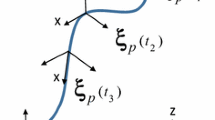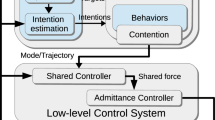Abstract
We propose an approach to efficiently teach robots how to perform dynamic manipulation tasks in cooperation with a human partner. The approach utilises human sensorimotor learning ability where the human tutor controls the robot through a multi-modal interface to make it perform the desired task. During the tutoring, the robot simultaneously learns the action policy of the tutor and through time gains full autonomy. We demonstrate our approach by an experiment where we taught a robot how to perform a wood sawing task with a human partner using a two-person cross-cut saw. The challenge of this experiment is that it requires precise coordination of the robot’s motion and compliance according to the partner’s actions. To transfer the sawing skill from the tutor to the robot we used Locally Weighted Regression for trajectory generalisation, and adaptive oscillators for adaptation of the robot to the partner’s motion.










Similar content being viewed by others
Explore related subjects
Discover the latest articles, news and stories from top researchers in related subjects.Notes
Stiffness is the inverse of compliance.
Error is equal to the difference between the demonstrated (desired) and learnt performance.
References
Adorno, B. V., Bo, A. P. L., Fraisse, P., & Poignet, P. (2011). Towards a cooperative framework for interactive manipulation involving a human and a humanoid. In 2011 IEEE international conference on robotics and automation (ICRA) (pp. 3777–3783).
Ajoudani, A., Tsagarakis, N. G., & Bicchi, A. (2012). Tele-impedance: Teleoperation with impedance regulation using a body-machine interface. The International Journal of Robotics Research, 31(13), 1642–1656.
Argall, B. D., & Billard, A. (2010). A survey of tactile human–robot interactions. Robotics and Autonomous Systems, 58(10), 1159–1176.
Argall, B. D., Chernova, S., Veloso, M., & Browning, B. (2009). A survey of robot learning from demonstration. Robotics and Autonomous Systems, 57(5), 469–483.
Atkeson, C. G., Hale, J. G., Pollick, F., Riley, M., Kotosaka, S., Schaal, S., et al. (2000). Using humanoid robots to study human behavior. IEEE Intelligent Systems, 15(4), 46–56.
Babič, J., Hale, J. G., & Oztop, E. (2011). Human sensorimotor learning for humanoid robot skill synthesis. Adaptive Behavior—Animals, Animats, Software Agents, Robots, Adaptive Systems, 19, 250–263.
Ben Amor, H., Berger, E., Vogt, D., & Jung, B. (2009). Kinesthetic bootstrapping: Teaching motor skills to humanoid robots through physical interaction. In Proceedings of the 32nd annual German conference on advances in artificial intelligence, KI’09 (pp. 492–499). Berlin, Heidelberg: Springer.
Ben Amor, H., Saxena, A., Kroemer, O., & Peters, J. (2012). Workshop: Beyond robot grasping—Modern approaches for learning dynamic manipulation. In 2012 IEEE/RSJ international conference on intelligent robots and systems.
Billard, A., Calinon, S., Dillmann, R., & Schaal, S. (2008). Robot programming by demonstration. In B. Siciliano & O. Khatib (Eds.), Springer handbook of robotics (pp. 1371–1394). Berlin: Springer.
Burdet, E., Osu, R., Franklin, D. W., Milner, T. E., & Kawato, M. (2001). The central nervous system stabilizes unstable dynamics by learning optimal impedance. Nature, 414(6862), 446–449.
Chiaverini, S. (1997). Singularity-robust task-priority redundancy resolution for real-time kinematic control of robot manipulators. IEEE Transactions on Robotics and Automation, 13(3), 399–410.
De Santis, A., Siciliano, B., De Luca, A., & Bicchi, A. (2008). An atlas of physical human–robot interaction. Mechanism and Machine Theory, 43(3), 253–270.
Edsinger, A., & Kemp, C. C. (2007). Human–robot interaction for cooperative manipulation: Handing objects to one another. In The 16th IEEE international symposium on robot and human interactive communication (2007) (pp. 1167–1172).
Evrard, P., Gribovskaya, E., Calinon, S., Billard, A., & Kheddar, A. (2009). Teaching physical collaborative tasks: object-lifting case study with a humanoid. In IEEE-RAS international conference on humanoid robots (pp. 399–404).
Franklin, D. W., Burdet, E., Osu, R., Kawato, M., & Milner, T. (2003a). Functional significance of stiffness in adaptation of multijoint arm movements to stable and unstable dynamics. Experimental Brain Research, 151(2), 145–157.
Franklin, D. W., Osu, R., Burdet, E., Kawato, M., & Milner, T. E. (2003b). Adaptation to stable and unstable dynamics achieved by combined impedance control and inverse dynamics model. Journal of Neurophysiology, 90, 3270–3282.
Gams, A., Ijspeert, A. J., Schaal, S., & Lenarčič, J. (2009). On-line learning and modulation of periodic movements with nonlinear dynamical systems. Autonomous Robots, 27(1), 3–23.
Gams, A., Petric, T., Ude, A., & Zlajpah, L. (2012). Performing periodic tasks: On-line learning, adaptation and synchronization with external signals. In R. Zaier (Ed.), The future of humanoid robots—research and applications (pp. 1–28). InTech.
Haykin, S. (1999). Neural networks: A comprehensive foundation. New Jersey: Prentice Hall.
Hersch, M., Guenter, F., Calinon, S., & Billard, A. (2008). Dynamical system modulation for robot learning via kinesthetic demonstrations. IEEE Transactions on Robotics, 24(6), 1463–1467.
Ijspeert, A. J., Nakanishi, J., & Schaal, S. (2002). Movement imitation with nonlinear dynamical systems in humanoid robots. In Proceedings 2002 IEEE international conference on robotics and automation (vol. 2, pp. 1398–1403).
Ikemoto, S., Ben Amor, H., Minato, T., Jung, B., & Ishiguro, H (2012). Physical human–robot interaction: Mutual learning and adaptation. IEEE Robotics Automation Magazine, 19(4), 24–35.
Kober, J., Wilhelm, A., Oztop, E., & Peters, J. (2012). Reinforcement learning to adjust parametrized motor primitives to new situations. Autonomous Robots, 33(4), 361–379.
Kormushev, P., Calinon, S., & Caldwell, D. G. (2011). Imitation learning of positional and force skills demonstrated via kinesthetic teaching and haptic input. Advanced Robotics, 25(5), 581–603.
Kremer, P., Wimböck, T., Artigas, J., Schätzle, S., Jöhl, K., Schmidt, F., et al. (2009). Multimodal telepresent control of dlr’s rollin’ justin. In Proceedings of the 2009 IEEE international conference on robotics and automation, ICRA’09 (pp. 3096–3097). Piscataway, NJ: IEEE Press.
Kroemer, O. B., Detry, R., Piater, J., & Peters, J. (2010). Combining active learning and reactive control for robot grasping. Robotics and Autonomous Systems, 58(9), 1105–1116.
Kushida, D., Nakamura, M., Goto, S., & Kyura, N. (2001). Human direct teaching of industrial articulated robot arms based on force-free control. Artificial Life and Robotics, 5(1), 26–32.
Lallee, S., Yoshida, E., Mallet, A., Nori, F., Natale, L., Metta, G., et al. (2010). Human–robot cooperation based on interaction learning. In O. Sigaud & J. Peters (Eds.), From motor learning to interaction learning in robots volume 264 of studies in computational intelligence (pp. 491–536). Berlin: Springer.
Maciejewski, A. A., & Klein, C. A. (1985). Obstacle avoidance for kinematically redundant manipulators in dynamically varying environments. The International Journal of Robotics Research, 4(3), 109–117.
Moore, B., & Oztop, E. (2012). Robotic grasping and manipulation through human visuomotor learning. Robotics and Autonomous Systems, 60(3), 441–451.
Muelling, K., Kober, J., Kroemer, O., & Peters, J. (2012). Learning to select and generalize striking movements in robot table tennis. In AAAI fall symposium series.
Niemeyer, G., Preusche, C., & Hirzinger, G. (2008). Telerobotics. In B. Siciliano & O. Khatib (Eds.), Springer handbook of robotics (pp. 741–757). Berlin: Springer.
Osu, R., & Gomi, H. (1999). Multijoint muscle regulation mechanism examined by measured human arm stiffness and emg signals. Journal of Neurophysiology, 81, 1458–1468.
Oztop, E., Lin, L.-H., Kawato, M., & Cheng, G. (2006). Dexterous skills transfer by extending human body schema to a robotic hand. In 2006 6th IEEE-RAS international conference on humanoid robots (pp. 82–87).
Peternel, L., & Babič, J. (2013a). Humanoid robot posture-control learning in real-time based on human sensorimotor learning ability. In 2013 IEEE international conference on robotics and automation (pp. 5309–5314).
Peternel, L., & Babič, J. (2013b). Learning of compliant human–robot interaction using full-body haptic interface. Advanced Robotics, 27(13), 1003–1012.
Petrič, T., Gams, A., Ijspeert, A. J., & Žlajpah, L. (2011). On-line frequency adaptation and movement imitation for rhythmic robotic tasks. The International Journal of Robotics Research, 30(14), 1775–1788.
Rasmussen, C. E., & Williams, C. K. I. (2006). Gaussian processes for machine learning. International Journal of Neural Systems, 14(2), 69–106.
Sauser, E. L., Argall, B. D., Metta, G., & Billard, A. G. (2012). Iterative learning of grasp adaptation through human corrections. Robotics and Autonomous Systems, 60(1), 55–71.
Schaal, S. (1999). Is imitation learning the route to humanoid robots? Trends in Cognitive Sciences, 3(6), 233–242.
Schaal, S., & Atkeson, C. G. (1998). Constructive incremental learning from only local information. Neural Computation, 10(8), 2047–2084.
Selen, L. P. J., Beek, P. J., & van Dieëbn, J. H. (2005). Can co-activation reduce kinematic variability? A simulation study. Biological Cybernetics, 93(5), 373–381.
Tsumugiwa, T., Yokogawa, R., & Hara, K. (2002). Variable impedance control with virtual stiffness for human-robot cooperative peg-in-hole task. In 2002 IEEE/RSJ international conference on intelligent robots and systems (vol. 2, pp. 1075–1081).
Acknowledgments
We thank L. Žlajpah for discussions and for providing us with the robot control infrastructure. This work was supported by the Slovenian Research Agency, programme P2-0076 and grant J2-2272, and the Slovenian Ministry of Higher Education, Science and Technology.
Author information
Authors and Affiliations
Corresponding author
Electronic supplementary material
Below is the link to the electronic supplementary material.
Supplementary material 1 (mpg 25622 KB)
Rights and permissions
About this article
Cite this article
Peternel, L., Petrič, T., Oztop, E. et al. Teaching robots to cooperate with humans in dynamic manipulation tasks based on multi-modal human-in-the-loop approach. Auton Robot 36, 123–136 (2014). https://doi.org/10.1007/s10514-013-9361-0
Received:
Accepted:
Published:
Issue Date:
DOI: https://doi.org/10.1007/s10514-013-9361-0




